Landscaping the ‘infrastructure’ for a resilient future
Increasing urbanisation and its sustainable management is a concern for many Indian cities. The interconnected issues linked to rising population are management of natural resources, their consumption, environmental degradation and waste management. Increasing demands to accommodate urbanisation is continuously reducing the natural landscape, erasing the characteristic qualities, fragmenting open spaces and disrupting ecosystems, all of which highlight a city’s clear departure from the intimate ties to the very landscape which gave rise to it. In this environmental crisis, the role of the city’s landscape needs to be brought to the forefront of the discussion towards reimagining our cities for a resilient future.
The landscape is capable of playing a multi-functional role providing ecological services as well as socio-cultural and recreational services for the citizens. Landscape infrastructure is a design approach to implement landscape as an integrated solution to growing urban issues of resource deficiency, climate change adaptability and resilience. The approach aims to utilise landscape components like natural and constructed wetlands, parks and gardens, riverways and drainage networks for scalable, sustainable interventions. The thought of moving away from single-purpose and rigid engineered infrastructure to landscape as infrastructure was guided by Pierre Belanger, who believed this to be multi-faceted and more flexible.
The roots of landscape infrastructure can be traced back to longtime efforts of environmental conservation to preserve bio-diversity and benefit people. The concept has been extended to the theory of landscape urbanism, positioning landscape as a primary system. The landscape today is being seen as the infrastructure of a new generation, which is as crucial as grey infrastructure to resolve socio-economic and environmental challenges. Water management, disaster risk management and climate adaptation are domains where landscape as infrastructure is integrated. The landscape contributes to temperature moderation, stormwater and wastewater management through sustainable drainage systems, filtering air pollutants, carbon sequestration along with promoting social cohesion through social interaction.
More and more cities are considering landscape infrastructure to complement and enhance grey infrastructure as a cost-effective, comprehensive and resilient approach. However, there is a need for a complete understanding and recognition of the potential and long-term benefits of landscape infrastructure by policymakers and design professionals for its better integration in city planning.
Landscape infrastructure needs to be seen as a critical public investment to reduce complete dependency on expensive grey infrastructure, in turn, reducing capital expenditure.
This article will provide an opportunity to discuss the importance of such lost capacities of our landscape, their characteristics and their natural potentials. Through examples of four case studies from the Delhi region, the article visualises the landscape structures in their multi-functional role of providing ecosystem and infrastructure services, opportunities for place making and assisting in adaptation towards climate risk for the cities of the future.
Delhi’s landscape structure
Historically, Delhi’s urban fabric emerged from its natural systems, integrated within a system of rivers, streams and forests. The city witnessed remarkable works of engineering for water management in the form of bundhs and baolis constructed between the 13th and 15th centuries.
However, over the last few decades, the land cover of the city has transformed drastically to accommodate its growing population. The significant loss of forests, waterbodies, rivers and their floodplains and streams converted into drains has resulted in a series of issues such as loss of biodiversity and rise in water and air pollution impacting the image of the city. With 50% of the capital’s territory being urbanised, concretisation is continuously reducing the porous surface required for recharge of underground reservoirs; the city’s water resources are getting exhausted, forcing it to depend on water drawn from outside its limits.
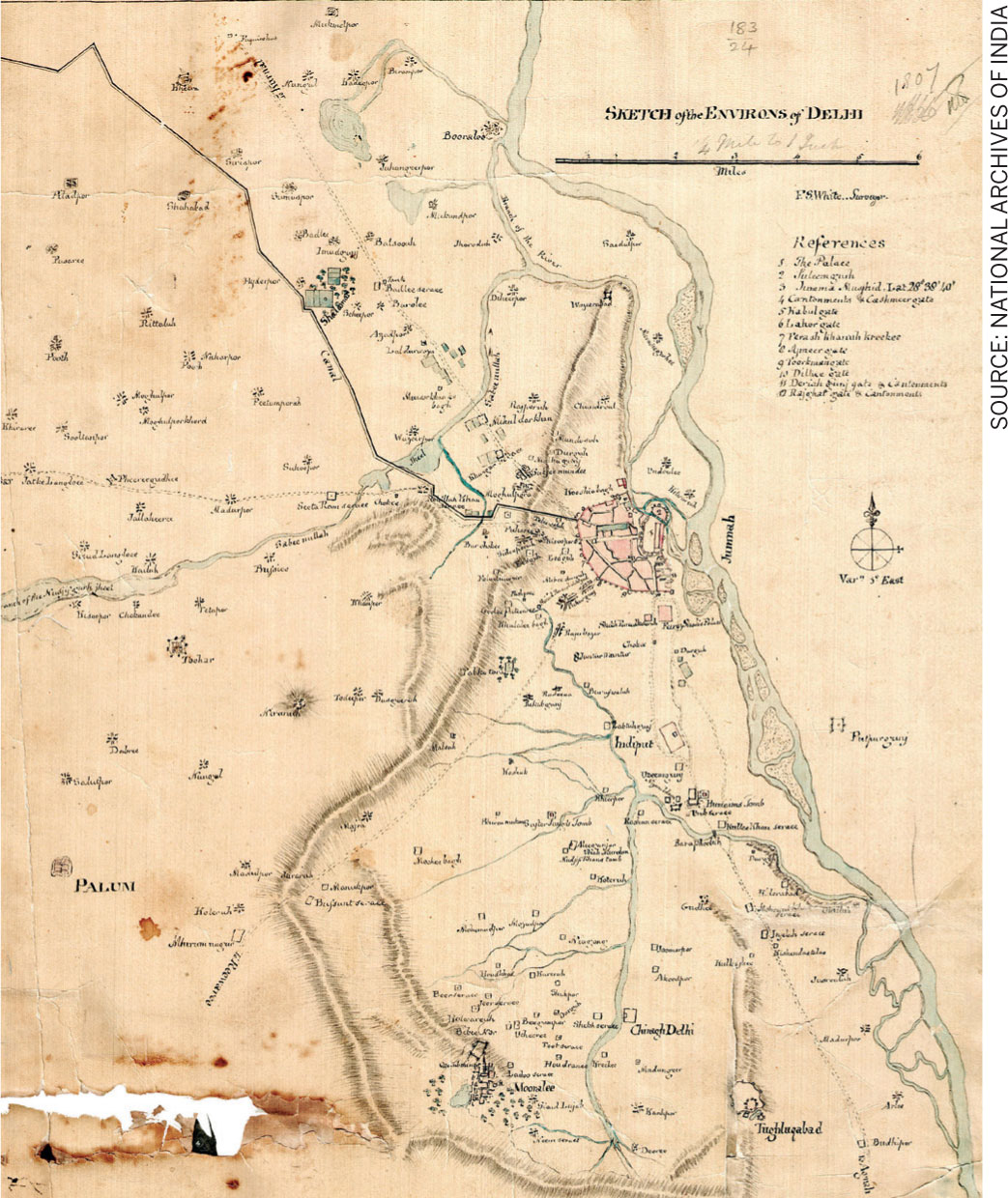
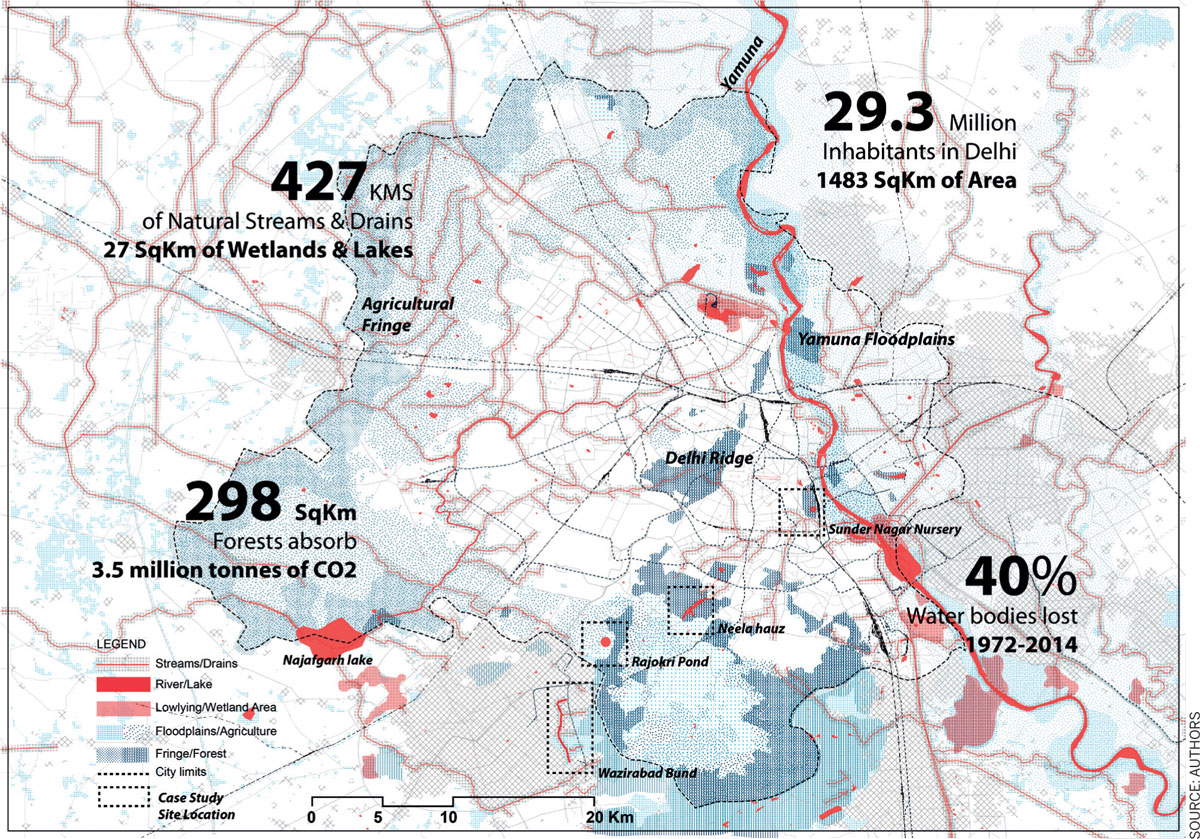
According to statistics (2011), out of the 611 water bodies in the city, 274 are already dry and the rest are not in a good condition. The green areas of the city are also continuously diminishing. The growing population puts tremendous pressure on sewage treatment infrastructure. With approximately 45% of the population not being connected to essential services, untreated water goes directly into the river. There is a need for a parallel, decentralised system which is multi-functional, flexible and resource efficient. In an endeavour to solve rising urban and environmental issues, the Delhi government is considering alternative strategies and embracing natural infrastructure. Rejuvenation of 159 water bodies and development of a network of bio-diversity parks are part of the green initiatives aiming towards a resilient city for social, economic and environmental benefits. The interventions are multi-functional in nature, providing integrated solutions for waste management, environmental rejuvenation and quality public spaces. In the following section, we will discuss four case studies from the Delhi region, which are part of a larger vision for a resilient city.
Rajokri Pond Community Landscape Project
Area: 1 hectare. Year: 2018
The Rajokri Pond community landscape project by the Delhi government is being envisaged as a pilot for rejuvenation of 159 water bodies in the city. The project uses the concept of feeding the artificial wetland with treated sewage water through a decentralised waste treatment system.
The Rajokri area is located around the ridge near the south-west part of Delhi. The area earlier used to be a dumping ground and the pond was full of wastewater from a nearby settlement. With new interventions, the area has transformed into a green community space. The basic concept of the project involves a natural STP (Sewage Treatment Plant) extending into system of public spaces. The process called SWAB (Scientific Wetland System with Active Bio-digester) involves feeding the raw sewage into a common inlet channel, which then gets transferred to an underground sedimentation tank and bio-digester. This process removes big particles and breakes down the solid components. The output then passes through an artificial wetland, to filter and remove toxic substances through organic processes before being diverted to the pond. An amphitheatre has been developed around the pond for public gatherings along with dedicated open areas for other community activities. A pathway runs along the edge with permeable paving and bio-swale to augment groundwater recharge during rainfall. The project provides much required open space within the informal settlement of Rajokri, used by locals for community gatherings during special occasions like festivals and for everyday activities.
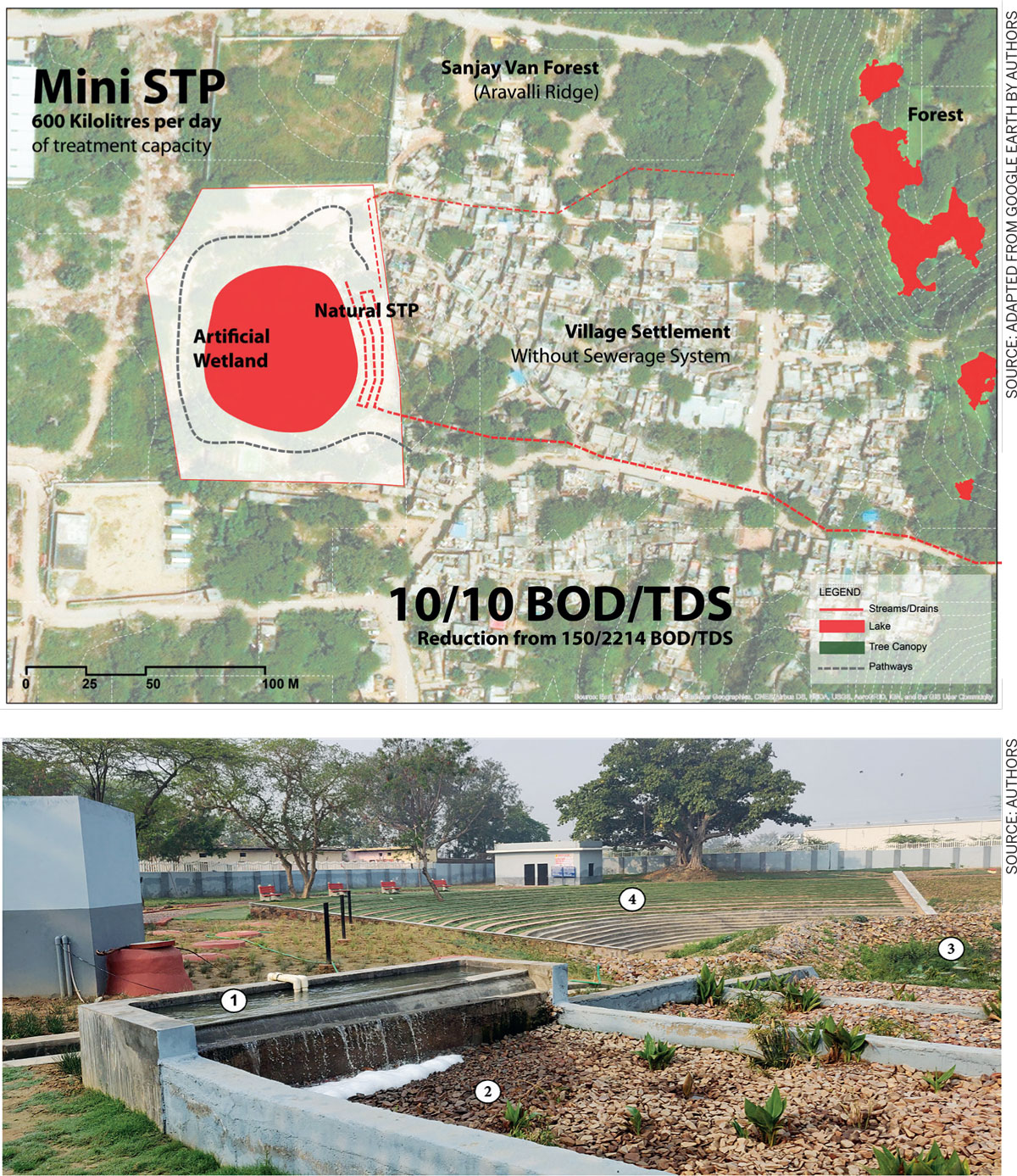
Bottom: View of the transformed village pond into the natural sewage treatment plant, acting as the new gathering place for the community.(1. Inlet Channel 2. Natural water treatment with pebbles and aquatic plants 3. Rajokri pond with treated water4. Amphitheatre)
Rajokri Pond is a pilot project for decentralized wastewater treatment on a local scale and the government is hoping to replicate more such projects throughout the city. Community greens are innovative tools to manage resilience, improve urban environments and integrate social learning with the inclusion of the local community. The revived area is approximately 1 hectare of which 2000 sq.m. is a waterbody. The plant has a capacity to treat 600 kilolitres of sewage per day.
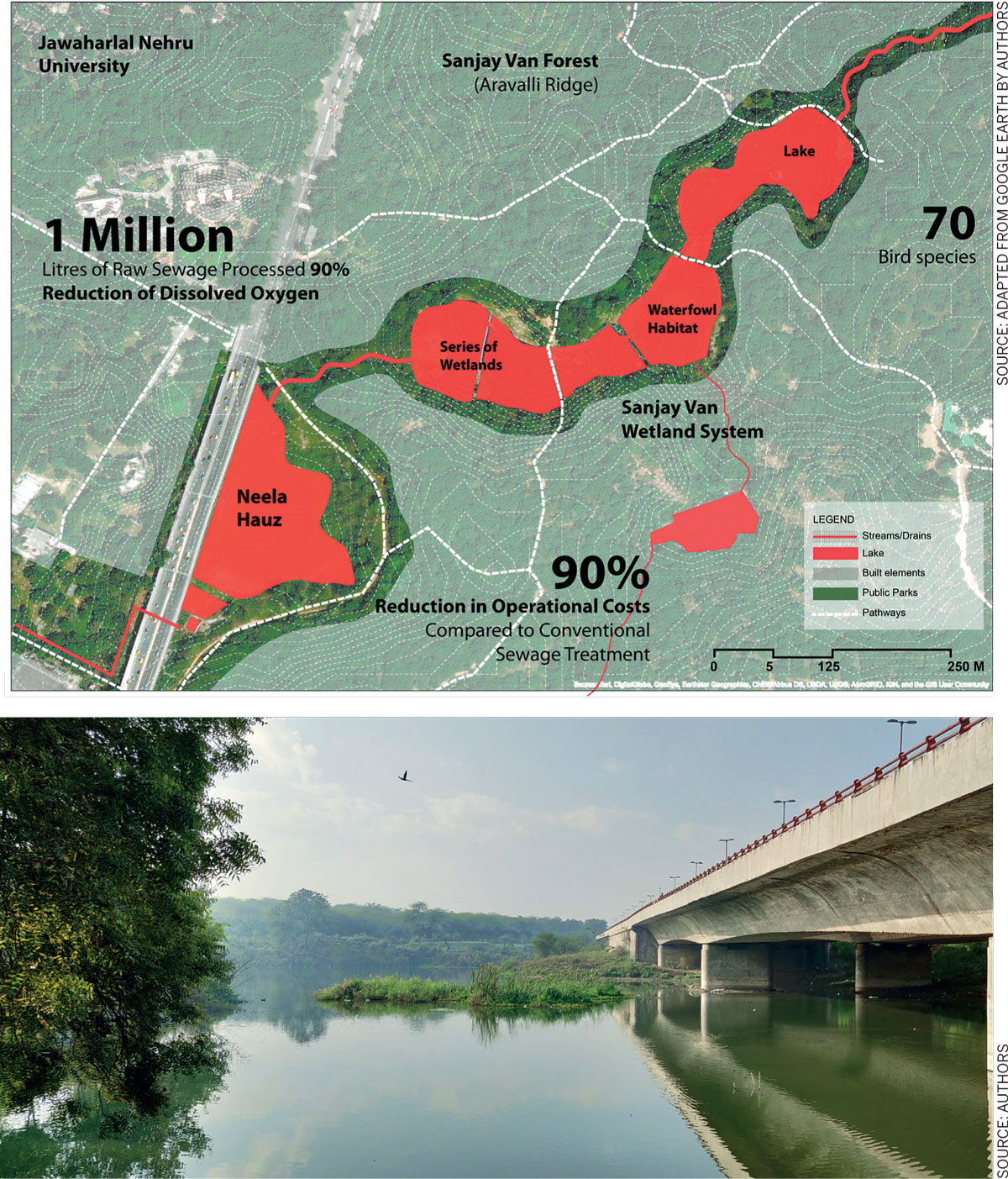
Bottom: View of Neela Hauz, highlighting the treated water quality in its final stage. This lake also serves as a protected habitat for flora and fauna
Neela Hauz Bio-Diversity Park
Area: 15 Hectares. Year: 2018. Capacity: 1 million litres of raw sewage
Neela Hauz (Blue Tank) in Sanjay Van is a constructed wetland system, which intakes raw sewage water from nearby settlements and semi-processed sewage from the nearby Vasant Kunj sewage treatment plant. The Hauz was the largest water body, collecting water from the entire forest catchment and supplied water to the nearby settlements such as Mehrauli all the way up to Hauz Khas tank and Siri. The lake fell into neglect due to urbanisation and the destruction of its water catchment area led to the waterbody drying up. In 2016, the Delhi Development Authority initiated the environmental rejuvenation of the lake, covering an area of approximately 2.5 ha. through a constructed wetland system. The water level is maintained by using STP treated water. The process includes storing the water in two steps and treating it with aquatic plants before finally releasing the water through channels and treatment points. Around 75 species of native trees are planted in the park. After the rejuvenation the project welcomed many migratory bird species. Habitat provision, protection of biodiversity and raising awareness about environmental conservation are integral parts of the project.
The constructed wetland system provides the benefit of water treatment through suspended and toxic particle reduction, groundwater recharge and flood controls. The system can be planned easily in the informal settlements, where existing infrastructure is absent, at unused land, old industrial and mining sites or barren flood plains. The process gives the benefit of improving the quality of water, which recharges the ground, providing long term benefits to the region. Other than environmental benefits and waste management, the project provides a beautiful and utilitarian green area to the city.
Eco-Restoration of Chakkarpur-Wazirabad Bund, Gurgaon
Area: 5 Km. Year: 2018
The bund was constructed as a flood control measure when Gurgaon used to be an assemblage of small villages. In the modern city, the bund had lost its purpose and became a wasteland. In 2015, with collaborative efforts of citizens and the Haryana Forest Department, the land was transformed into a 5.2 km long linear park.
The concept of the project was to create a barrier-free ecological network, using the potential of redundant natural infrastructure.
The park has cycle tracks and pedestrian walkways connected to nearby residential areas. The walkway is porous and water runoff is directed towards the drain running parallel to the tracks. The edges of the drain are also kept natural and help in stormwater management. Approximately 30,000 indigenous trees and shrub species are planted in the park.
The project is an excellent example of community ownership and awareness to take responsibility of their natural resources. It provides much needed green space for the citizens and has been part of many community events like plantation drives by the youth, nature awareness campaigns for children and promoting social cohesion and integration.
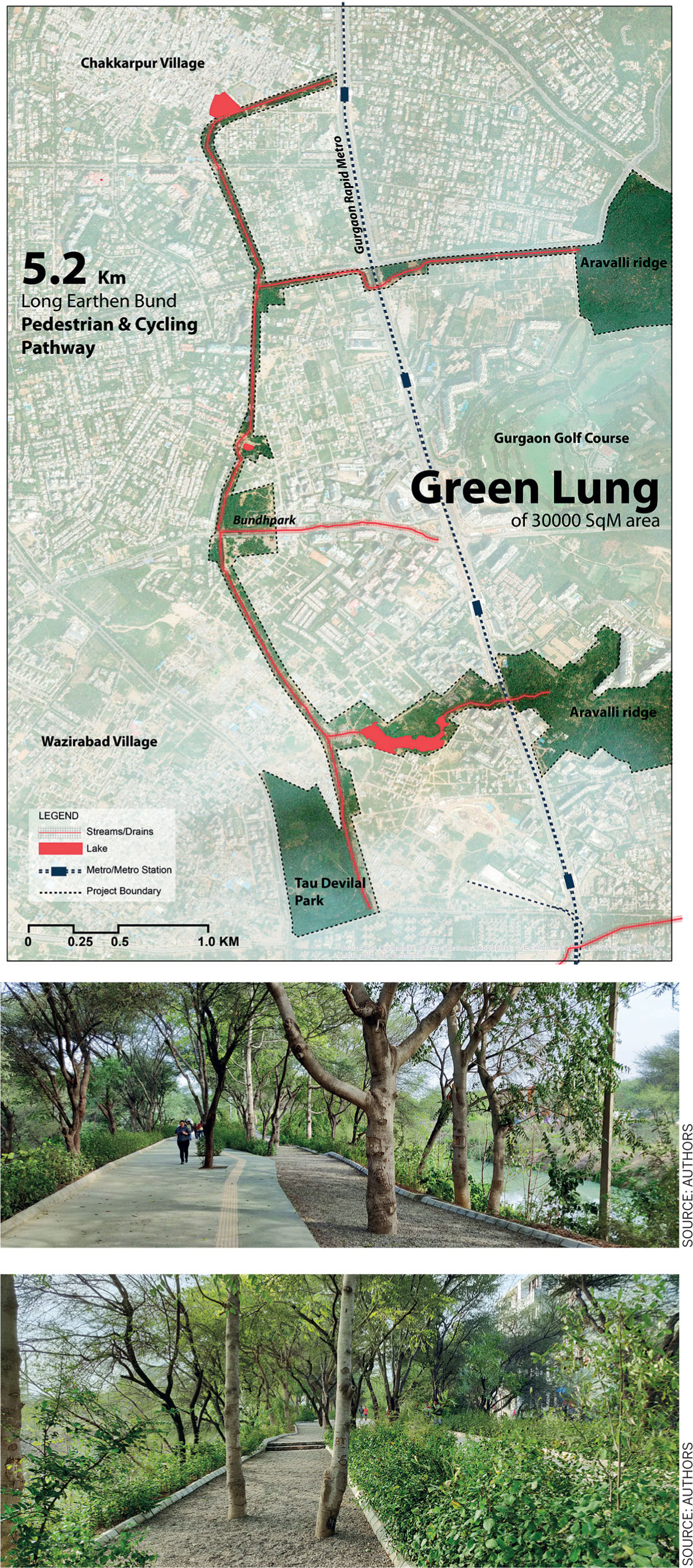
Middle: View of the 5-km long linear ‘bundh’ park used as a shared path for walking, jogging and cycling along water body
Bottom: The project integrated existing site features such as levels and trees by carefully merging them with the use of permeable surfaces
Sunder Nagar Nursery
Area: 90 Acres. Year: 2018
Established in the early 20th century, Sunder Nagar served as a nursery for the British for several decades before being pushed under construction rubble. The restoration work for the nursery started with a memorandum of understanding between the CPWD and the Aga Khan Trust for Culture. The project brings together conservation of microbiology and environmental upgradation spread over an area of 90 acres. The project masterplan includes formal and informal gardens, ponds, lakes, orchards, nurseries and recreational areas. A central axis of 500 metres has been designed conceptually tracing the path of the Grand Trunk Road connecting 16th-century Humayun’s Tomb and Azimganj Serai. The nursery, which is also the first arboretum in the city, has almost 300 species of trees. The landscape here is perceived as a productive component, a move away from a widely accepted norm of a merely aesthetically pleasing space. The vision combines restoration of built heritage, an ecological forest and a nursery while providing a utilitarian landscape. Thirty acres of the ecological zone have been developed representing native micro-habitats, which are open for the public. In the future, the project will further include the gardens of Humayun’s Tomb, the National Zoological Park, Millennium Park and Old Fort to form an extended green cover of 600 acres. A connected stretch of greens is crucial for the habitation of bio-diversity and also from an ecological perspective.
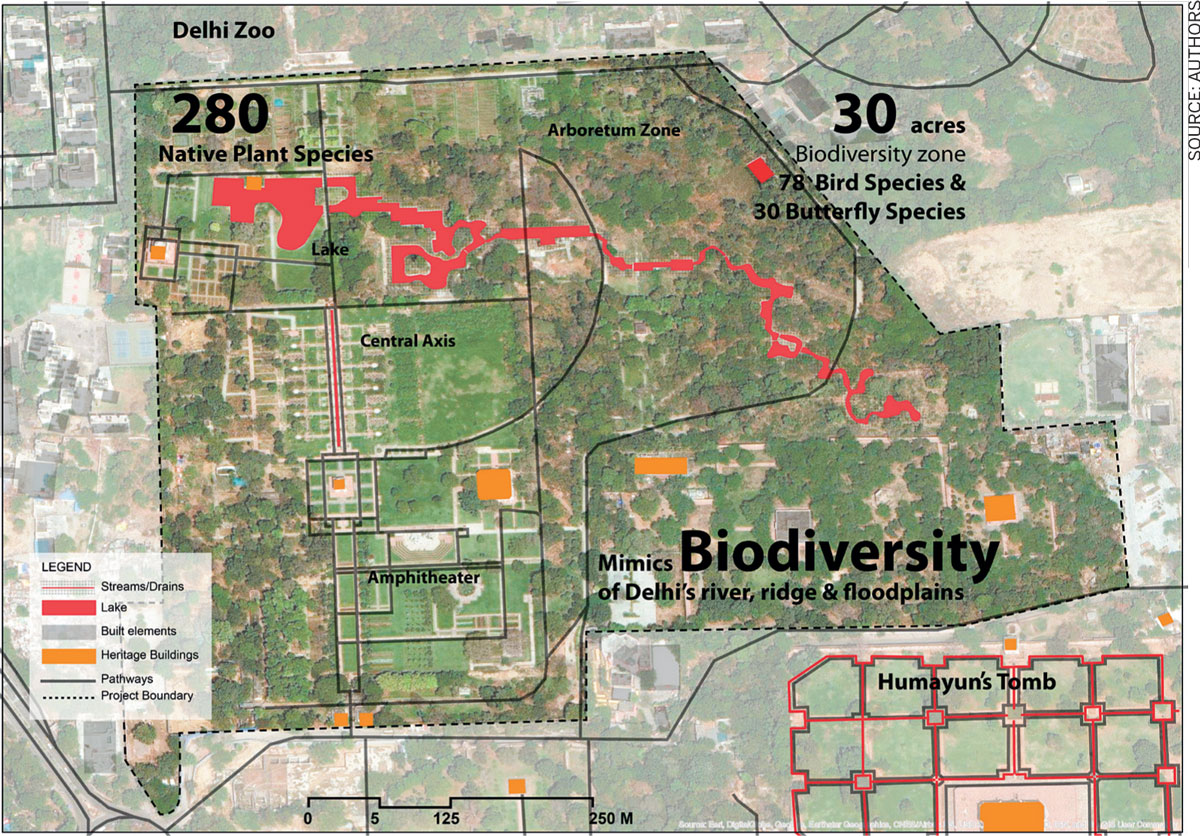

Right: The lake extends to form a microhabitat zone, in an approach to simulate the quickly disappearing diversity of Delhi’s biodiversity
Way Forward
As suggested by scholars, a city is to be conceptualised as an ecosystem, not only a place of consumption and problems, but also a place which holds hopes and opportunities towards a resilient urban future. Landscape as infrastructure presents us with one such opportunity. The implementation of landscape infrastructure needs to be planned as a long term strategic spatial vision at the local and regional level. Present planning policy should be adapted to engage landscape infrastructure in city vision policies and plans. The planning process should be developed with an interdisciplinary and transdisciplinary approach to involve a wider realm of knowledge. Acknowledgment and the right interpretation of landscape as crucial infrastructure is essential for its transition from a concept to a practical solution.

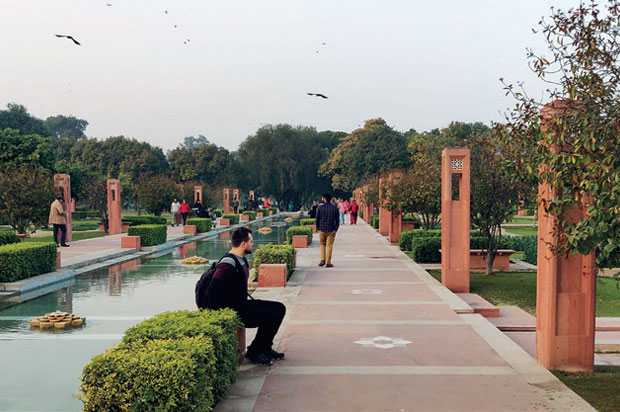

Comments (0)